#pachycephalosauria
Text
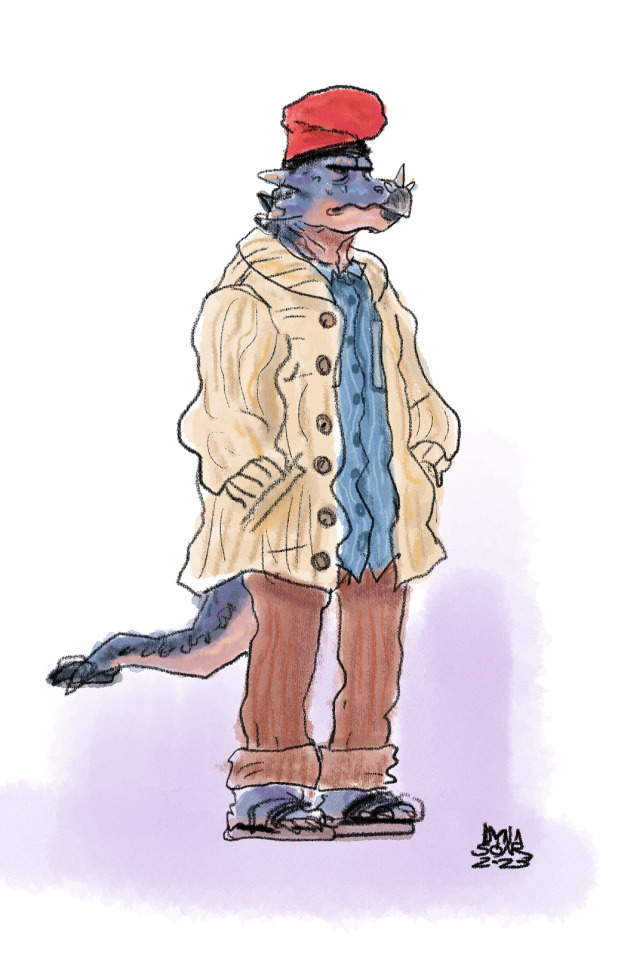
me yesterday
#drawing#sketch#art#digital art#anthro art#furry art#self portrait#doodle#cartoon#dinosaur#saurian#ornithischian#ankylosauria#pachycephalosauria#anthro#furry#barretina#dynasoar5#ssohardd
160 notes
·
View notes
Text
Sphaerotholus triregnum Woodruff et al., 2023 (new species)
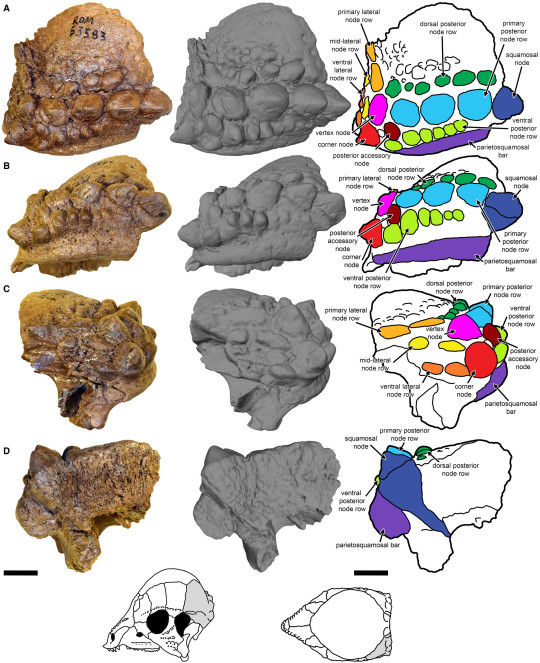
(Type squamosal [bone in the back of the skull] of Sphaerotholus triregnum [scale bars = 1 cm], from Woodruff et al., 2023)
Meaning of name: triregnum = triregnum [a domed, three-crowned ceremonial head piece worn by popes of the Catholic Church during the 14th Century]
Age: Late Cretaceous (Maastrichtian), between 66.9–67.2 million years ago
Where found: Hell Creek Formation, Montana, U.S.A.
How much is known: A nearly complete left squamosal (one of the bones in the back of the skull).
Notes: S. triregnum was a pachycephalosaur, a group of herbivorous dinosaurs famous for their thickened, domed skull. Three other species of Sphaerotholus had previously been named, S. goodwini from the Kirtland Formation of New Mexico; S. buchholtzae, also from the Hell Creek Formation, as well as the Frenchman Formation of Saskatchewan; and S. edmontonensis from the Horseshoe Canyon Formation of Alberta.
Despite being very incompletely known, S. triregnum can be distinguished from S. goodwini and S. buchholtzae in having three rows of bony bumps along the back of the squamosal, instead of only one. Squamosals have not been found for S. edmontonensis, but it had a distinctive character in that one of the bumps on the adjacent parietal bone would have also been partly formed by the squamosal (a feature found in S. buchholtzae as well), whereas the equivalent bump in S. triregnum originates from the squamosal alone.
Although some pachycephalosaurs (including S. buchholtzae) appear to have undergone dramatic changes in skull shape during growth, the arrangement of the numerous small bumps in the back of their heads seems to have remained fairly stable throughout their lifetimes, and is thus considered a reliable feature for identifying distinct species. Along with the also newly-named S. lyonsi from the Dinosaur Park Formation of Alberta, S. triregnum indicates that small pachycephalosaurs were likely more diverse than previously appreciated, even in well-studied Late Cretaceous fossil sites of North America.
Reference: Woodruff, D.C., R.K. Schott, and D.C. Evans. 2023. Two new species of small-bodied pachycephalosaurine (Dinosauria, Marginocephalia) from the uppermost Cretaceous of North America suggest hidden diversity in well-sampled formations. Papers in Palaeontology 9: e1535. doi: 10.1002/spp2.1535
#Palaeoblr#Dinosaurs#Sphaerotholus triregnum#Late Cretaceous#North America#Pachycephalosauria#2023#Extinct
43 notes
·
View notes
Text
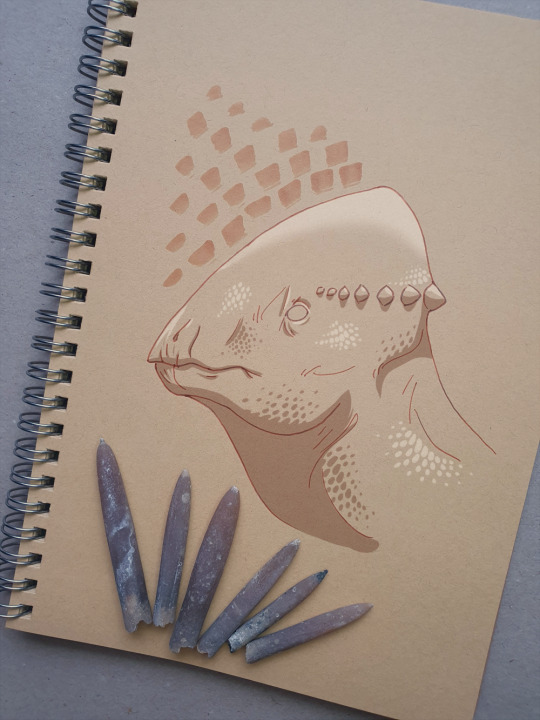
Day 25: Tylocephale gilmorei
#paleoart#art#dinosaur#prehistoric#paleontology#digitalart#traditionalart#Archosaur#Archovember2023#Archovember#Dinovember#Dinovember2023#DrawDinovember#DrawDinovember2023#Tylocephale#Tylocephalegilmorei#Pachycephalosauria#paleoblr#digital art#palaeoblr
31 notes
·
View notes
Text

Day 14: Microcephale
A unpublished specimen of pachycephalosauridae originated from Dinosaur Park formation in Alberta, Canada. Also this one is no bigger than a house cat, and it could make sense if it got filaments integumentary.
#my art#dinosaur#paleoart#myart#dinosaurs#dinosauria#my drawings#pachycephalosauria#marginocephalia#ornithischia#sketchbookapp#sketchbook app#artists on tumblr
10 notes
·
View notes
Text
Dinofact #62
All known pachycepahlosaurs, except for two species, Ferganocephale and Stenopelix lived during the late Cretaceous. Ferganocephale, which can be traced back to the middle Jurassic, lacks some features on its teeth distinctive to all other known pachycephalosaurs, and Stenopelix, traced to the early Cretaceous, is based on a partial skeleton lacking the skull, which some scientists have now reclassified as a ceratopsian. With both outlying species of pachycephalosaurs sometimes considered nomen dubiums, it is possible that all known pachycephalosaurs lived during the late Cretaceous period.
Source: Wikipedia [1], [2], [3]
#dinosaur#dinosaurs#paleontology#pachycephalosaur#pachycephalosaurs#pachycephalosauria#ferganocephale#stenopelix#cretaceous#late cretaceous#cretaceous period#late cretaceous period#early cretaceous#early cretaceous period#jurassic#jurassic period#middle jurassic period#middle jurassic#mid jurassic#mid jurassic period#nomen dubium#fun facts#trivia#dinosaur trivia#dinosaur fun facts#26th#october#2022#october 26th#october 2022
11 notes
·
View notes
Text

@theaterrush inserted ;
"You look like you've got something to say." (Blanca to Blathers,) (if you're still taking these that is :3)

Blathers' eyes immediately light up at the opportunity to speak , taking a moment to pause in an attempt to better organize his thoughts ( which are always moving faster than his beak can , but not by much ) before piping up. ❛ In fact , I do ! ❜

❛ I was just thinking about the Pachycephalosauria. The name Pachycephalosauria means " thick headed lizards " , and their namesake thick skulls are widely assumed to have been adapted for fighting. It's just fascinating ! ❜
#blathers╭┈─ [ 01. in character ]#loading . . .╭┈─ [ answered asks ]#╭┈─ [ theaterrush . . . blanca ]#i hope this is ok ! :)
4 notes
·
View notes
Text

#dinosaur#dinosaurs#dino#Pachycephalosaurus#thick-headed lizard#Pachycephalosauria#Pachycephalosaurs#Herbivore#Dinosaur art#Funny#Funny Dinosaur#Meme#Dinosaur meme#Bald men#Bald#Fight#Dinosaur fight#Friar Tuck#cretaceous#cretaceous dinosaur#mesozoic#Pachycephalosaurini#Pachycephalosauridae#Head butt#Head butting dinosaur#male pattern baldness
74 notes
·
View notes
Photo
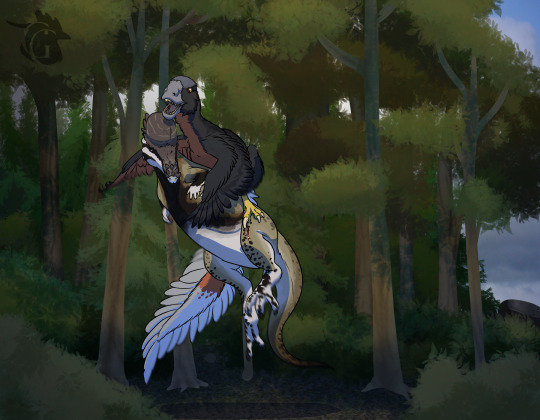
Dinosaur Day 7-8 Pachycephalosaurus and Dakotaraptor
Buck Buck Buckaroo!
A slightly too young Dakotaraptor tries their luck at tackleing something bigger than them, and it doesn’t look like it goes too well for either of them.
I felt kind of sick today, so I’m going to take a break tomorrow- hence the double-feature.
#Dinovember#Dinosaur#Pachycephalosaurus#Dakotaraptor#Pachycephalosauria#Deinonchychosauria#Goldenchocobo's Art
46 notes
·
View notes
Photo
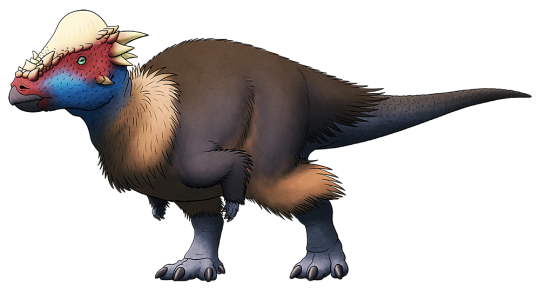
Weird Heads Month #18: Boneheaded Dinosaurs
Pachycephalosaurs are highly recognizable dinosaurs with their thick spiky skulls, and it's not hugely surprising that they were the evolutionary cousins of the equally weird-headed ceratopsians.
Much like their frilled relatives they had beaks at the tips of their snouts and large gut cavities for digesting plant matter, but they also had surprisingly sharp theropod-like teeth in front of their more standard herbivore teeth further back – suggesting they may also have been opportunistic omnivores, occasionally snacking on carrion or small animals similarly to modern pigs or bears.
Their striking-looking dome heads were probably used for combat, headbutting or flank-butting each other, and many fossil skulls show evidence of injuries that would have been caused by that sort of behavior.
The eponymous Pachycephalosaurus wyomingensis lived in North America right at the end of the Cretaceous, about 70-66 million years ago. It was one of the largest of its kind, reaching lengths of around 4.5m (14'9"), and was characterized by a large bony dome-head surrounded by small blunt spikes.
But it turns out that was probably only what it looked like as a fully mature adult.
Recent discoveries of juvenile Pachycephalosaurus skulls confirmed a hypothesis proposed a few years earlier: these dinosaurs changed appearance drastically as they grew up, and younger individuals had been mistaken for separate species. They started off with domeless flat heads, bristling with long spikes (a form previously named Dracorex hogwartsia) then as they matured their domes began to grow (previously Stygimoloch spinifer) and by full maturity they had big domes with the spikes shrunk down to smaller stubbier knobs (the classic Pachycephalosaurus look).
This particular reconstruction depicts a Stygimoloch-like subadult individual, not quite fully mature and still sporting some longer spikes.

———
Nix Illustration | Tumblr | Pillowfort | Twitter | Patreon
#weird heads 2020#science illustration#paleontology#paleoart#palaeoblr#pachycephalosaurus#pachycephalosauria#marginocephalia#neornithischia#ornithischia#dinosaur#speculative fluffiness#feather ALL the dinosaurs#art#more than meets the eye#dracorex#stygimoloch#shame about those two other names; they were excellent
265 notes
·
View notes
Text
Sphaerotholus lyonsi Woodruff et al., 2023 (new species)
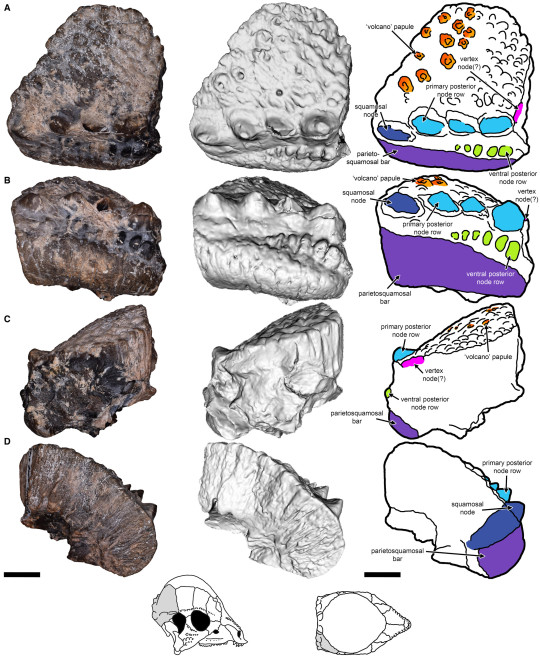
(Type squamosal [bone in the back of the skull] of Sphaerotholus lyonsi [scale bars = 1 cm], from Woodruff et al., 2023)
Meaning of name: lyonsi = for Randy Lyons [discoverer of the original fossil]
Age: Late Cretaceous (Campanian), about 76.1 million years ago
Where found: Dinosaur Park Formation, Alberta, Canada
How much is known: A nearly complete right squamosal (one of the bones in the back of the skull).
Notes: S. lyonsi was a pachycephalosaur, a group of herbivorous dinosaurs famous for their thickened, domed skull. Three other species of Sphaerotholus had previously been named, S. goodwini from the Kirtland Formation of New Mexico, S. buchholtzae from the Hell Creek Formation of Montana and the Frenchman Formation of Saskatchewan, and S. edmontonensis from the Horseshoe Canyon Formation of Alberta.
Despite being very incompletely known, S. lyonsi can be distinguished from S. goodwini and S. buchholtzae in having two rows of bony bumps along the back of the squamosal, instead of only one. Squamosals have not been found for S. edmontonensis, but it had a distinctive character in that one of the bumps on the adjacent parietal bone would have also been partly formed by the squamosal (a feature found in S. buchholtzae as well), whereas the equivalent bump in S. lyonsi originates from the squamosal alone.
Although some pachycephalosaurs (including S. buchholtzae) appear to have undergone dramatic changes in skull shape during growth, the arrangement of the numerous small bumps in the back of their heads seems to have remained fairly stable throughout their lifetimes, and is thus considered a reliable feature for identifying distinct species. Along with the also newly-named S. triregnum from the Hell Creek Formation, S. lyonsi indicates that small pachycephalosaurs were likely more diverse than previously appreciated, even in well-studied Late Cretaceous fossil sites of North America.
Reference: Woodruff, D.C., R.K. Schott, and D.C. Evans. 2023. Two new species of small-bodied pachycephalosaurine (Dinosauria, Marginocephalia) from the uppermost Cretaceous of North America suggest hidden diversity in well-sampled formations. Papers in Palaeontology 9: e1535. doi: 10.1002/spp2.1535
#Palaeoblr#Dinosaurs#Sphaerotholus lyonsi#Late Cretaceous#North America#Pachycephalosauria#2023#Extinct
22 notes
·
View notes
Photo

Day 25: Pachycephalosaurus wyomingensis
#Pachycephalosaurus wyomingensis#Pachycephalosaurus#Pachycephalosaurini#Pachycephalosauridae#Pachycephalosauria#Ornithischia#paleoart#paleoblr#palaeoblr#dinosaur#paleontology#archovember#archovember2022#dinovember2022#dinovember#art#digital art
36 notes
·
View notes
Text
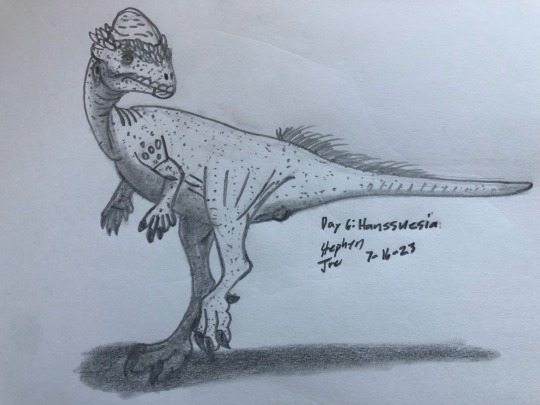
Day 6: Hanssuesia
A Pachycephalosaurid is synonymously known as Stegoceras (as of 2023 publication by three authors) of Judith River Formation.
#my art#dinosaur#paleoart#dinosaurs#myart#dinosauria#my drawings#ornithischia#marginocephalia#pachycephalosauria#pachycephalosauridae#hanssuesia#stegoceras#Judith River July#artists on tumblr#sketch pad
8 notes
·
View notes
Text
thinkin bout pachycephalosauria
boy do they got some cool domes
1 note
·
View note
Text
侏儸紀世界:冥河龍
冥河龍 Stygimoloch,
屬於厚頭龍類,
學名意思為 ” 冥河的魔鬼 “
比起其他的厚頭龍類,
冥河龍的頭頂比較小而平坦,
頭骨四周尖刺也比較多。

在侏儸紀世界:殞落國度中,
將主角 歐文與克萊兒 從牢中救出的就是今天的主角,
破壞了恐龍拍賣會的也是本尊,
雖說看起來攻擊性很強,
其實冥河龍是吃素的。
之前介紹過 侏儸紀世界:適者生存 的遊戲中,
屬於史詩級的恐龍。

在適者生存中,
技能分別為:
護盾攻擊、衝擊後逃跑、立即衝撞三種,
但很可惜的,
生命值稍低了些,
實用的程度不是很高。

View On WordPress
0 notes
Photo

Dinovember day 7 - Pachycephalosauria
Quick sketch of a Prenocephale!
#Dinovember#Dinovember 2020#DrawDinovember#dinosaurs#dinosaurios#Prenocephale#dinoart#paleoart#paleontology#paleoillustration
58 notes
·
View notes
Photo





Dinovember 2020 – Week 1
We are really happy to see that many liked the prompt we made this year for Dinovember 2020! So here I leave you a selection of works from last week I found mostly on Instagram and Tumblr.
Days 1 and 2 - Oviraptosauria & Ceratopsia
@frautierfreund was the first person in showing us her work! She decided to draw an Oviraptor. A lot of kids also wanted to join us, like Ludovico here who draw a Pachyrhinosaurus, sent by his mom @alba.munoz1303 .
Days 3 and 4 - Sauropoda & Stegosauria
Some artists wanted to do the exact dinosaurs we suggested, like the case of @only_eddf who drew this Sauroposeidon with its young, or @pasu-chan who drew this beutiful Wuerhosaurus traditionally!
Days 5 and 6 - Tyrannosauridae & Ankylosauridae
Of course, The creators of El Fósil Viviente had to do some art too! So @pyroraptor42-art drew an Alioramus while @vicugna.art sculpted a tiny Zuul in clay!
Days 7 and 8 - Pachycephalosauria & Deinonychosauria
Finally @goldenchocobo combined these 2 days very creatively, showing us a fierce fight between a Pachycephalosaurus and a Dakotaraptor!
We hope you are having fun and hopefully we see more works this week, good luck everybody! Good luck! 😉
2 notes
·
View notes